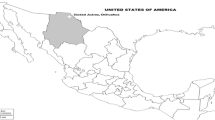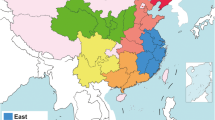Abstract
The aim of this study was to evaluate the DDT, DDE, and 1-hydroxypyrene exposure levels of children living in communities located in southeastern Mexico. The study communities were Lacanja and Victoria in Chiapas state and Ventanilla in Oaxaca state. Children living in Lacanja had total blood DDT levels (mean ± SD, 29,039.6 ± 11,261.4 ng/g lipid) that were significantly higher than those of children in Victoria (10,220.5 ± 7,893.1 ng/g lipid) and Ventanilla (11,659.7 ± 6,683.7 ng/g lipid). With respect to the 1-hydroxypyrene levels in urine samples, the levels in Lacanja (4.8 ± 4.1 μg/L or 4.5 ± 3.9 μmol/mol creatinine) and Victoria (4.6 ± 3.8 μg/L or 3.9 ± 3.0 μmol/mol Cr) were significantly higher than levels found in Ventanilla (3.6 ± 1.4 μg/L or 2.5 ± 0.5 μmol/mol Cr). In conclusion, our data indicate high levels of exposure in children living in the communities studied in this work. The evidence found in this study could be further used as a trigger to revisit local policies on environmental exposures.

Similar content being viewed by others
References
ATSDR. (2013). Toxicological profile for polycyclic aromatic hydrocarbons. Agency for toxic substances and diseases registry. Atlanta, GA. USA. http://www.atsdr.cdc.gov/toxprofiles/tp69.pdf. Accessed on 19-04-2013.
Domínguez-Cortinas, G., Díaz-Barriga, F., Martínez-Salinas, R. I., Cossío, P., & Pérez-Maldonado, I. N. (2013). Exposure to chemical mixtures in Mexican children: high-risk scenarios. Environmental Science Pollution Research Internacionales, 20(1), 351–357.
Direccion General de Epidemiologia Secretaria de Salubridad y Asistencia (DGE SSA). (1996). Boletín de Paludismo y otras enfermedades transmitidas por vector. 6, 2–10.
Eskenazi, B., Chevrier, J., Rosas, G. L., Anderson, H. A., Bornman, M. S., Bouwman, H., Chen, A., Cohn, B. A., Jager, C., Henshel, D. S., Leipzig, F., Leipzig, L. S., Lorenz, E. C., Snedeker, S. M., & Stapleton, D. (2009). The Pine River Statement: human health consequences of DDT use. Environmental Health Perspectives, 117, 1359–1367.
Fan, R., Wang, D., Mao, C., Ou, S., Lian, Z., Huang, S., Lin, Q., Ding, R., She, J. (2012). Preliminary study of children’s exposure to PAHs and its association with 8-hydroxy-2'-deoxyguanosine in Guangzhou, China. Environment International. 2012;42:53–58.
Franco, S. S., Nardocci, A. C., & Günther, W. M. (2008). PAH biomarkers for human health risk assessment: a review of the state-of-the-art. Cadernos de Saúde Pública, 24, s569–s580.
Freire, C., Abril, A., Fernández, M. F., Ramos, R., Estarlich, M., Manrique, A., Aguirre, A., Ibarluzea, J., & Olea, N. (2009). Urinary 1-hydroxypyrene and PAH exposure in 4-year-old Spanish children. Science of the Total Environment, 407, 1562–1569.
Hu, S. W., Chan, Y. J., Hsu, H. T., Wu, K. Y., Changchien, G. P., Shie, R. H., & Chan, C. C. (2011). Urinary levels of 1-hydroxypyrene in children residing near a coal-fired power plant. Environmental Research, 111, 1185–1191.
Jacob, J., & Seidel, A. (2002). Biomonitoring of polycyclic aromatic hydrocarbons in human urine. Journal of Chromatography. B, Analytical Technologies in the Biomedical and Life Sciences, 778, 31–47.
Jongeneelen, F. J. (2001). Benchmark guideline for urinary 1-hydroxypyrene as biomarker of occupational exposure to polycyclic aromatic hydrocarbons. The Annals of Occupational Hygiene, 45, 3–13.
Lee, M., Eum, K., Zoh, M., Kim, T., Pak, Y., & Paek, D. (2007). 1-Hydroxypyrene as a biomarker of PAH exposure among subjects living in two separate regions from a steel mill. International Archives of Occupational and Environmental Health, 80, 671–678.
Linderholm, L., Jakobsson, K., Lundh, T., Zamir, R., Shoeb, M., Nahar, N., & Bergman, Å. (2011). Environmental exposure to POPs and heavy metals in urban children from Dhaka. Bangladesh. Journal of Environmental Monitoring, 13, 2728–2734.
Mucha, A. P., Hryhorczuk, D., Serdyuk, A., Nakonechny, J., Zvinchuk, A., Erdal, S., Caudill, M., ScheV, P., Lukyanova, E., Shkiryak-Nyzhnyk, Z., & Chislovska, N. (2006). Urinary 1-hydroxypyrene as a biomarker of PAH exposure in 3-year-old Ukrainian children. Environmental Health Perspectives, 114, 603–609.
Martínez-Salinas, R. I., Elena Leal, M., Batres-Esquivel, L. E., Domínguez-Cortinas, G., Calderón, J., Díaz-Barriga, F., & Pérez-Maldonado, I. N. (2010). Exposure of children to polycyclic aromatic hydrocarbons in Mexico: assessment of multiple sources. International Archives of Occupational and Environmental Health, 83, 617–623.
Martínez-Salinas, R. I., Pérez-Maldonado, I. N., Batres-Esquivel, L. E., Flores-Ramírez, R., & Díaz-Barriga, F. (2012). Assessment of DDT, DDE, and 1-hydroxypyrene levels in blood and urine samples in children from Chiapas Mexico. Environmental Science Pollution Research Internacionales, 19, 2658–2666.
Nhanes, I. V. (2009). Fourth national report on human exposure to environmental chemicals. Atlanta: Department of Health and Human Services Centers for Disease Control and Prevention.
Pérez-Maldonado, I. N., Trejo, A., Ruepert, C., Jovel, R., Del, C., Méndez, M. P., Ferrari, M., Saballos-Sobalvarro, E., Alexander, C., Yáñez-Estrada, L., Lopez, D., Henao, S., Pinto, E. R., & Díaz-Barriga, F. (2010). Assessment of DDT levels in selected environmental media and biological samples from Mexico and Central America. Chemosphere, 78, 1244–1249.
Pruneda-Álvarez, L. G., Pérez-Vázquez, F. J., Salgado-Bustamante, M., Martínez-Salinas, R. I., Pelallo-Martínez, N. A., & Pérez-Maldonado, I. N. (2012). Exposure to indoor air pollutants (polycyclic aromatic hydrocarbons, toluene, benzene) in Mexican indigenous women. Indoor Air, 22, 140–147.
Riojas-Rodríguez, H., Schilmannm, A., Marron-Mares, A. T., Masera, O., Li, Z., Romanoff, L., Sjödin, A., Rojas-Bracho, L., Needham, L. L., & Romieu, I. (2011). Impact of the improved Patsari biomass stove on urinary polycyclic aromatic hydrocarbons biomarkers and carbon monoxide exposures in rural Mexican women. Environmental Health Perspectives, 119, 1301–1307.
Ruchirawat, M., Settachan, D., Navasumrit, P., Tuntawiroon, J., & Autrup, H. (2007). Assessment of potential cancer risk in children exposed to urban air pollution in Bangkok. Thailand. Toxicology Letters, 168, 200–209.
Schulz, C., Angerer, J., Ewers, U., Heudorf, U., Wilhelm, M., & on behalf of the Human Biomonitoring Commission of the German Federal Environment Agency. (2009). Revised and new reference values for environmental pollutants in urine or blood of children in Germany derived from the German Environmental Survey on Children 2003–2006 (GerES IV). International Journal of Hygiene and Environmental Health, 212, 637–647.
Taussky HH (1954) A micro-colorimetric determination of creatinine in urine by the JaVey’s reaction. J Biol Chem 208:853–861.
Torres-Dosal, A., Pérez-Maldonado, I. N., Jasso-Pineda, Y., Martinez-Salinas, R. I., Alegría-Torres, J. A., & Díaz-Barriga, F. (2008). Indoor air pollution in a Mexican indigenous community: evaluation of risk reduction program using biomarkers of exposure and effect. Science of the Total Environment, 390, 362–368.
Trejo-Acevedo, A., Díaz-Barriga, F., Carrizales, L., Domínguez, G., Costilla, R., Ize-Lema, I., Yarto-Ramírez, M., Gavilán-García, A., Mejía-Saavedra, J., & Pérez-Maldonado, I. N. (2009). Exposure assessment of persistent organic pollutants and metals in Mexican children. Chemosphere, 74, 974–980.
Trejo-Acevedo, A., Rivero-Pérez, N. E., Flores-Ramírez, R., Orta-García, S. T., Varela-Silva, J. A., & Pérez-Maldonado, I. N. (2012). Assessment of the levels of persistent organic pollutants and 1-hydroxypyrene in blood and urine samples from Mexican children living in an endemic malaria area in Mexico. Bulletin of Environmental Contamination and Toxicology, 88, 828–832.
Tuntawiroon, J., Mahidol, C., Navasumrit, P., Autrup, H., & Ruchirawat, M. (2007). Increased health risk in Bangkok children exposed to polycyclic aromatic hydrocarbons from traffic-related sources. Carcinogenesis, 28, 816–822.
UNEP. (2012). Stockholm Convention on Persistent Organic Pollutants (POPs). Text and annexes. Geneva, Switzerland; 20011–64. Available from: www.unep.org. Accessed 16 Feb 2012.
Acknowledgments
This work was supported by a grant from the Consejo Nacional de Ciencia y Tecnología, Mexico, CONACYT-SEMARNAT 107900.
Author information
Authors and Affiliations
Corresponding author
Rights and permissions
About this article
Cite this article
Pérez-Maldonado, I.N., Trejo-Acevedo, A., Pruneda-Alvarez, L.G. et al. DDT, DDE, and 1-hydroxypyrene levels in children (in blood and urine samples) from Chiapas and Oaxaca, Mexico. Environ Monit Assess 185, 9287–9293 (2013). https://doi.org/10.1007/s10661-013-3251-y
Received:
Accepted:
Published:
Issue Date:
DOI: https://doi.org/10.1007/s10661-013-3251-y




